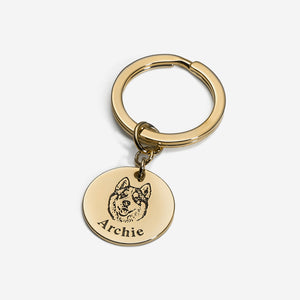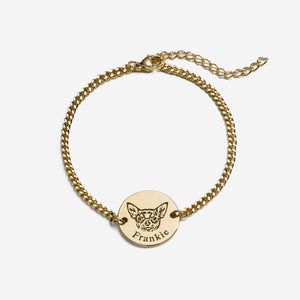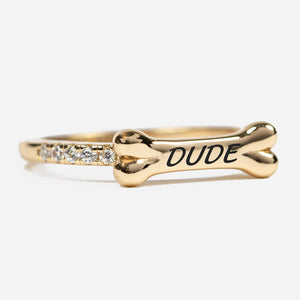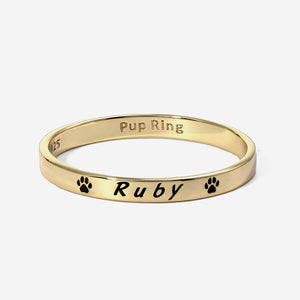If you are like most dog owners, you’ve probably been on at least one walk with an overly enthusiastic pup. Getting dragged around the block to the point you can’t feel your arm isn’t very fun. If your dog lunges at distractions, you may even be nervous about going on a walk at all. Whether it’s pulling, barking, distractions, or something else, there is probably an area for improvement on your walks.
No matter what you’re struggling with, if you’re longing for a peaceful, perfectly paced walk, look no further! Here are 6 of the most common problems you might have on a walk, and how you can fix them!
1 Way too excited
The path to the perfect walk starts before you even go out the front door. No matter how much you love your pup’s little happy-dance, if they are too hyper before you even pick up the keys or their leash, it’s a little overboard. You want to set the tone for your walk right away, which means a cool and collected pup.
The solution to a totally hyper pup? Wait till they calm down to put their leash on. Cookie gets PUMPED UP for walkies like no other dog I have ever known (I can’t even spell the word o-u-t without him getting visibly excited), but he knows he needs to be still so I can get his leash on. Even though I can tell he is really excited, he also knows he needs to show respectful behaviour and manners before we walk out that door. That means sitting while the leash goes on and not rushing the door. By starting a walk with these fundamentals, you set the tone for a better behaved, more pleasant experience for both you and your dog.
By the way, whenever you go through a doorway with your pup, it’s good practice to be sure you are the first through the door, not your dog. This further teaches your dog to be patient and wait for your lead.
2 Pulling
Pulling is probably the biggest problem dog owners encounter during walks. When I first adopted Cookie, this was our number one problem and it took a lot of effort to solve it. There are tons of products specifically designed and marketed to dog owners whose pups drag them along on walks, promising to solve all their problems if they throw money at it. In the end, the cheapest and most wholesome solution is through training. Of course, having the right tool helps too.
The best leash for walking most dogs is a simple slip lead. It looks weak and plain at first, but it’s a powerful tool because it gives you control over your dog’s gaze. If you’re afraid of your dog breaking loose, and are not comfortable using just a slip lead, you can use it in addition to your normal leash. The trick is to have the lead sit just under your dog’s chin. If your dog starts going the wrong way, or seems focused on something they shouldn’t be, a light tug can redirect their focus forward.
 If there is one leash you definitely should not buy, it’s those retractable ones. It may seem easy and you might think it’s good for letting your dog wander while still being attached to you without a bunch of leash dragging on the ground, but it’s a bad decision to use this type of leash. Why? It gives your dog the sensation of always pulling away at the leash. It’s just teaching your dog that it’s normal to always feel that pressure and to always be working against it. That’s definitely the opposite of what you want, and the pressure that’s put on your dog’s neck while pulling isn’t healthy either.
If there is one leash you definitely should not buy, it’s those retractable ones. It may seem easy and you might think it’s good for letting your dog wander while still being attached to you without a bunch of leash dragging on the ground, but it’s a bad decision to use this type of leash. Why? It gives your dog the sensation of always pulling away at the leash. It’s just teaching your dog that it’s normal to always feel that pressure and to always be working against it. That’s definitely the opposite of what you want, and the pressure that’s put on your dog’s neck while pulling isn’t healthy either.
Another quick tip to reduce pulling- get out that energy! If your dog is dragging you along, your dog may not be getting enough exercise. Although a walk is also meant to be exercise in itself, spending a little time beforehand playing fetch or a bit of tug to wear out your pup may give you an easier time. If your dog is a little less hyper when you walk out the door, you may find your walk to be much more leisurely and focused.
3 Going too slow
If your dog is spending the whole walk smelling flowers and the underside of every leaf in sight, you might feel a little frustrated and impatient. First and foremost, it is very important to give your dog the time they need during walks to be healthy. No matter how much of a rush you’re in, a walk should be long enough to get your dog some exercise, spend a bit of time experiencing the outside world, and to do their doggy business.
That being said, there’s a difference between letting your pup smell a few flowers and spending your entire walk doing more sniffing around than moving along. If you can’t seem to get your dog to focus on your walk, try using a shorter leash and having certain stops along your normal route that are dedicated to a bit of sniffing.
4 Lunging
One of the scariest parts of walking a dog is lunging. If the sight of anything- whether it be a squirrel, or another dog- causes your dog to lunge forward, it can be uncomfortable. Not only could it potentially hurt you, or knock you down if you have a pup on the bigger side, the prospect of your dog breaking from your grasp to chase something can lead to a dangerous situation.
First you need to determine what is causing your dog to lunge, and then you can work on their behavior and some intense counterconditioning. For this example let’s say your dog likes to lunge at squirrels. Your main goal would be to desensitize your dog to the sight of squirrels to the point that your pup is able to behave and focus on you in their presence.
 Besides general behavioral training and spending a bit more time tiring out your pup, there are a few different steps when it comes to desensitizing your dog to squirrels. You’ll be doing something called counterconditioning. What that means is, when your dog experiences a stimulus (squirrel) you counter that with something even more enticing (focus on you with good treats). The timing is important and probably the trickier part of all this. When you notice a squirrel on your walk, you’ll want to get your dog’s attention before they even know it’s there. Ideally the squirrel will be very far away, to the point that when your dog notices it, it’s not close enough to be overly tempting compared to you and your treats. Essentially, you are teaching your dog that if there is a squirrel, they get treats for focusing on you instead! And as soon as the squirrel is gone, so are the treats.
Besides general behavioral training and spending a bit more time tiring out your pup, there are a few different steps when it comes to desensitizing your dog to squirrels. You’ll be doing something called counterconditioning. What that means is, when your dog experiences a stimulus (squirrel) you counter that with something even more enticing (focus on you with good treats). The timing is important and probably the trickier part of all this. When you notice a squirrel on your walk, you’ll want to get your dog’s attention before they even know it’s there. Ideally the squirrel will be very far away, to the point that when your dog notices it, it’s not close enough to be overly tempting compared to you and your treats. Essentially, you are teaching your dog that if there is a squirrel, they get treats for focusing on you instead! And as soon as the squirrel is gone, so are the treats.
5 Stopping
You may have a problem that’s much different from these- a pup that stops and does not want to go on any longer. If your dog stops in the middle of a walk and refuses to move any more, first you’ll want to consider its health. Is it overheating or dehydrated? You’ll want to rule out these issues first and foremost before you consider your plan of action.
If your pup tires easily, opt for shorter walks. Make sure you bring water, especially if it’s really warm where you live and you plan to be out for a long time. However, if your dog is just being a little stubborn, that’s different. You can use your lead to tug their gaze towards the right direction and let them know where you’re supposed to be going.
You can also pick up your pup and start walking home. If that’s where they want to go, they’ll be more motivated to tag along on their own legs since you got the message. If they’re not done being out and about, they’ll probably scurry around in the opposite direction. If nothing else, you’ve gotten your pup moving again!
6 Won’t potty
If the main goal of your walks is to get your dog to “do their business”, then it can be frustrating if they just don’t seem to get it. By the way, we’ve got a blog post all about how to easily potty train your pup!
My first and foremost tip is to have a designated command for your pup to go! The biggest mistake many dog owners make is continually asking their dog to potty anytime they’re outdoors. We’ve talked about this before- words have the meaning you give them! When you choose your word (for Cookie, it’s “go potty”), wait until you can see your dog is definitely about to go, then say your command once. Immediately praise your dog once they go, rinse and repeat. The better you are at timing this, the faster your dog will understand what you want from them.
Keep in mind that it’s best to give your dog a bit of time to walk around a bit first to help “get things moving”. While you don’t want your pup to sniff all day long, giving them a bit of time and space to do their thing is important.
My final tip here is that it is VERY important that you don’t take your dog on a walk to potty and then immediately turn around to go back inside. If you do this enough, your dog will learn that going potty means that their fun walk will end. The last thing you want is to build a negative association with a desired behavior. Instead, make sure when your pup goes, you let them know how much you appreciate it and reward them with a bit of play or a longer walk!
Other tips
When you’re practicing good behavior on walks, it’s a good idea to start training close to home. It takes time for dogs to translate skills they already have into new situations. If you’re trying to teach your dog a new behavior, or modify an old one, help them learn faster by starting in an environment with fewer distractions. This can mean you stop right outside your front door sometimes to work on good behavior! If it’s an extreme case, you may even decide to practice being on a leash in your living room. Wherever your dog starts to struggle, start working on their behavior a step before that, and build your way up.
 If you struggle with walks due to other misbehaved dogs in the neighborhood, the best thing you can do is to continue practicing your pup’s own good behavior, and when possible, take a different route with fewer distractions and obstacles. In my neighborhood, there are several dogs that tend to bark and misbehave, or are even permitted to roam off leash even with signs posted requiring them to be leashed. When Cookie and I see another pup down the road that might cause trouble, we turn back around and walk in the other direction, or we may even head back inside and try again later. It might also help to pick a different time for your walks when there are fewer distractions out and about. You may even find that you and your pup enjoy walking at a different time better, whether it’s due to different people outside, or even if you find you have better energy at a different time of day!
If you struggle with walks due to other misbehaved dogs in the neighborhood, the best thing you can do is to continue practicing your pup’s own good behavior, and when possible, take a different route with fewer distractions and obstacles. In my neighborhood, there are several dogs that tend to bark and misbehave, or are even permitted to roam off leash even with signs posted requiring them to be leashed. When Cookie and I see another pup down the road that might cause trouble, we turn back around and walk in the other direction, or we may even head back inside and try again later. It might also help to pick a different time for your walks when there are fewer distractions out and about. You may even find that you and your pup enjoy walking at a different time better, whether it’s due to different people outside, or even if you find you have better energy at a different time of day!
What’s your favorite part about walking your dog?
Do you like just being outdoors? Meeting new people? Maybe you like watching your dog just be excited! No matter what, think about something you enjoy when walking your dog to help you get motivated to make the most of it! You can also let us know your favorite part of dog walks, or maybe tell us where you’re struggling so we can help! Thanks again for reading and I look forward to writing more in the future!







